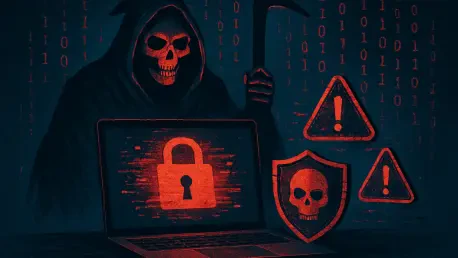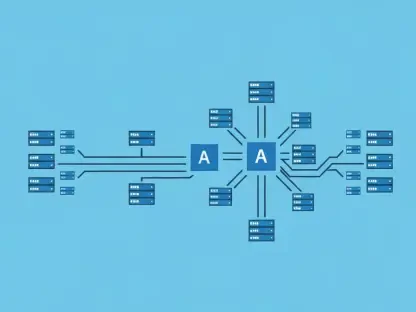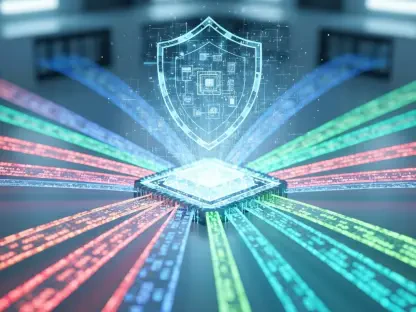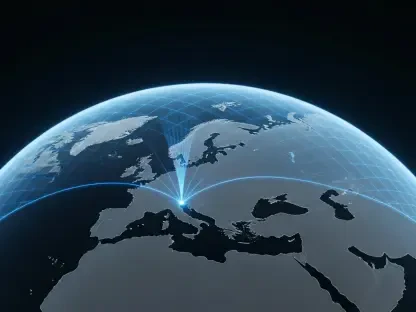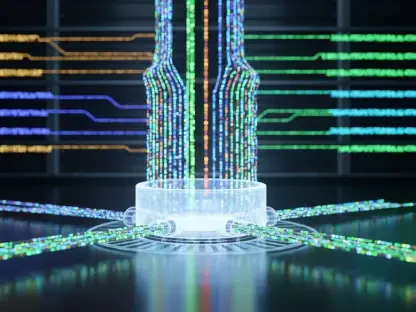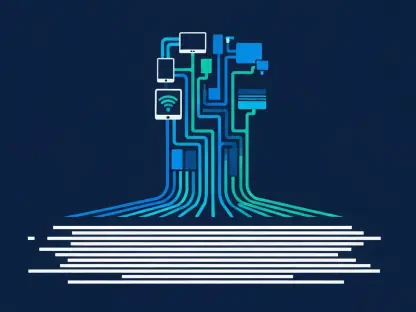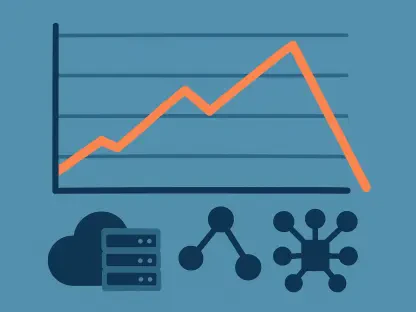In an era where cyber threats evolve with alarming speed, the emergence of Charon ransomware stands as a stark reminder of the increasingly sophisticated nature of digital attacks, posing significant risks to targeted sectors. Recently identified by Trend™ Research, this ransomware family has been deployed in a highly targeted campaign against Middle Eastern public sector entities and aviation industries, sectors where disruptions can have profound consequences. Unlike traditional ransomware that casts a wide net for victims, Charon tailors its ransom notes to explicitly name specific organizations, revealing a deliberate and calculated approach to extortion. This precision, combined with the adoption of tactics typically associated with advanced persistent threat (APT) groups like Earth Baxia, marks a dangerous shift in the ransomware landscape. The blending of stealthy, espionage-driven methods with financially motivated attacks creates a hybrid threat that challenges even the most robust security frameworks. As cybercriminals continue to refine their strategies, understanding Charon’s mechanisms and its parallels with APT operations becomes crucial for enterprises aiming to safeguard critical operations.
Unpacking Charon’s Sophisticated Attack Mechanisms
Stealth Through Evasion Techniques
Charon ransomware distinguishes itself through a meticulous design that prioritizes evasion, borrowing heavily from the playbook of APT groups. At the core of its strategy lies the exploitation of legitimate binaries, such as Edge.exe, to sideload malicious DLLs, a technique that masks its presence by blending with trusted processes. This method, often seen in covert operations targeting sensitive environments, allows the ransomware to decrypt and inject its payload into common Windows services like svchost.exe. Such stealthy maneuvers are crafted to bypass conventional security tools, ensuring that the malware remains undetected until encryption begins. This level of sophistication in evading endpoint detection and response (EDR) systems mirrors the persistent, low-profile tactics used by elite threat actors to maintain access over extended periods, highlighting how ransomware operators are adopting espionage-grade methods for financial gain.
Beyond initial evasion, Charon demonstrates a layered approach to staying under the radar, incorporating multi-stage payload delivery that adds complexity to detection efforts. Encrypted shellcode, hidden within innocuous-looking files, undergoes several decryption phases before revealing the final ransomware executable. This intricate process not only delays identification by security solutions but also complicates reverse-engineering attempts by analysts. Additionally, the presence of a dormant anti-EDR driver in the ransomware’s code—though inactive in the current variant—suggests potential for future iterations to directly challenge security tools. Such forward-thinking design reflects a strategic mindset akin to APT campaigns, where anticipating defensive countermeasures is a key component of sustained operations, further blurring the lines between ransomware and state-sponsored threats.
Precision in Encryption and Disruption
Charon’s approach to encryption is as calculated as its evasion tactics, employing a hybrid scheme that balances speed with devastating impact. Utilizing advanced cryptographic methods like Curve25519 elliptic curve cryptography paired with the ChaCha20 stream cipher, it fully encrypts smaller files while selectively targeting portions of larger ones. This partial encryption strategy ensures rapid compromise without diminishing the ransomware’s leverage over victims, as critical data remains inaccessible without the decryption key. The deliberate choice to preserve system functionality by avoiding certain file extensions like .exe or .dll underscores a focus on pressuring organizations into payment rather than rendering systems entirely inoperable. This nuanced balance of disruption and coercion echoes the strategic precision often seen in APT-driven attacks, where the goal is to maximize impact while maintaining control over the target environment.
Complementing its encryption capabilities, Charon engages in pre-encryption behaviors designed to cripple recovery options and amplify damage. Actions such as stopping security-related services, terminating active processes, deleting shadow copies, and clearing the Recycle Bin are executed with ruthless efficiency to hinder any chance of data restoration. These destructive steps, while increasingly common among modern ransomware strains, are performed with a level of intent that suggests a deep understanding of enterprise recovery mechanisms. The ransomware’s ability to customize its behavior through command-line parameters further enhances its adaptability, allowing attackers to prioritize specific network shares or local paths for encryption. This tailored approach to disruption, reminiscent of APT campaigns that meticulously plan sabotage to align with strategic objectives, positions Charon as a uniquely formidable adversary in the cyber threat landscape.
Understanding the Convergence of Ransomware and APT Tactics
Technical Overlaps with Earth Baxia
One of the most striking aspects of Charon ransomware is its technical resemblance to tactics employed by Earth Baxia, an APT group notorious for stealthy operations in government sectors. Techniques like DLL sideloading and process injection, central to Charon’s attack chain, are hallmarks of Earth Baxia’s methodology, originally honed for espionage purposes. These methods allow attackers to exploit trusted processes and maintain a low profile while executing malicious activities, a strategy that has now been repurposed for financial extortion. While direct evidence linking Charon to Earth Baxia remains elusive, the overlap in toolchains and delivery mechanisms suggests either deliberate imitation or access to a shared ecosystem of cybercriminal resources. This convergence illustrates a broader trend where ransomware developers are elevating their capabilities by adopting elite tactics, making attribution increasingly complex in today’s threat environment.
The ambiguity surrounding Charon’s origins further underscores the fluidity of modern cybercrime networks, where techniques are often shared or replicated across disparate groups. Even if no direct collaboration exists, the adoption of APT-style evasion methods by ransomware operators signals a democratization of advanced tools once reserved for state-sponsored actors. This shift poses significant challenges for cybersecurity professionals attempting to map the threat landscape, as overlapping tactics obscure clear distinctions between actors. Charon’s use of encrypted shellcode delivery via DLLs, a technique closely aligned with Earth Baxia’s approach, exemplifies how such methodologies are no longer exclusive to espionage but are now leveraged for rapid, disruptive attacks. As these technical parallels continue to emerge, organizations must focus on behavioral indicators rather than specific attributions to effectively counter these hybrid threats.
Strategic Targeting Similarities
Beyond technical similarities, Charon shares a strategic alignment with Earth Baxia in its focus on high-value targets such as government entities and aviation industries. These sectors, critical to national infrastructure and economic stability, are prime targets for both APT groups seeking intelligence and ransomware operators aiming for substantial payouts. Charon’s customized ransom notes, which explicitly name victim organizations, indicate a level of reconnaissance and planning akin to APT campaigns that prioritize impact over volume. This shift from broad, opportunistic ransomware attacks to precision-driven operations reflects a deeper understanding of target environments, likely facilitated by extensive pre-attack intelligence gathering. Such strategic targeting maximizes the pressure on victims to comply with ransom demands, as downtime or data loss in these industries can have cascading consequences.
The implications of this targeted approach extend beyond immediate financial losses, as the reputational and operational stakes for affected organizations are immense. Much like Earth Baxia’s campaigns, which often exploit the geopolitical or economic significance of their targets, Charon’s focus on critical sectors suggests an intent to exploit systemic vulnerabilities for maximum leverage. The ransomware’s ability to propagate across network shares, scanning and encrypting accessible resources while avoiding detection-prone administrative paths, further mirrors APT tactics of silent lateral movement to expand control within a compromised environment. This strategic overlap highlights how ransomware is evolving into a more calculated threat, adopting the long-term planning and high-stakes focus of APT operations to devastating effect. Enterprises in sensitive industries must therefore reassess their risk profiles, recognizing that they are no longer just targets of random attacks but of meticulously orchestrated campaigns.
Business Impact and Defensive Challenges
Heightened Risks to Enterprises
The fusion of APT tactics with ransomware’s immediate destructive power, as exemplified by Charon, significantly elevates the risks faced by enterprises, particularly those in critical sectors. Beyond the obvious threat of data loss, the ransomware jeopardizes operational continuity, with the potential to halt essential services in industries like aviation or government where downtime can have far-reaching effects. Financial costs from ransom payments, recovery efforts, and regulatory penalties compound the damage, while reputational harm can erode stakeholder trust long after systems are restored. Charon’s network propagation capabilities amplify these risks, enabling it to spread across shared resources and potentially paralyze entire infrastructures if unchecked. This dual nature of stealthy infiltration and widespread disruption creates a formidable challenge, as traditional security measures often fail to address the full spectrum of such hybrid threats, leaving organizations vulnerable to cascading impacts.
Moreover, the targeted nature of Charon’s attacks means that even well-defended entities are at risk if initial access is gained through human-centric vectors like phishing or insider compromise. The ransomware’s ability to customize its encryption priorities and adapt to specific environments underscores the attackers’ intent to maximize impact on high-value targets, where the stakes of non-compliance with ransom demands are exceptionally high. This calculated approach not only increases the likelihood of payment but also places immense pressure on organizations to prioritize cybersecurity investments amidst competing operational demands. The convergence of APT-level evasion with ransomware’s rapid damage potential thus necessitates a fundamental shift in how enterprises perceive and mitigate cyber risks, recognizing that the consequences of such attacks extend far beyond immediate technical failures to encompass broader strategic and economic repercussions.
Evolving Defense Needs
To counter the sophisticated threat posed by Charon, organizations must adopt a multilayered defense strategy that addresses both technical vulnerabilities and human factors. Hardening systems against DLL sideloading and process injection is a critical starting point, requiring strict controls over executable permissions and vigilant monitoring of suspicious process chains. Protecting EDR solutions from tampering ensures that detection capabilities remain intact, while restricting lateral movement through network segmentation and limited access to sensitive shares can curb the ransomware’s propagation. Robust backup practices, including offline or immutable copies, are essential to mitigate the impact of pre-encryption disruptions like shadow copy deletion, providing a lifeline for recovery without succumbing to ransom demands. These technical measures, though vital, must be continuously updated to keep pace with evolving tactics that mirror APT-level sophistication, ensuring resilience against both current and future iterations of such threats.
Equally important is the role of user awareness training and privilege management in preventing initial compromise, as many attacks exploit human error or social engineering tactics to gain a foothold. Educating employees on recognizing phishing attempts and enforcing least-privilege access policies can significantly reduce the attack surface, complementing technical defenses with proactive prevention. Advanced threat intelligence solutions also play a pivotal role, offering insights into emerging indicators of compromise and enabling security teams to hunt for threats like Charon before they fully manifest. By integrating these strategies, organizations can build a comprehensive defense framework that not only reacts to incidents but anticipates them, addressing the strategic intent behind targeted ransomware campaigns. As cyber threats continue to blend espionage tactics with extortion, such holistic approaches become indispensable for safeguarding critical operations and maintaining trust in an increasingly hostile digital landscape.
Future-Proofing Against Hybrid Threats
Looking ahead, the rise of hybrid threats like Charon signals a need for organizations to rethink cybersecurity as a dynamic, ongoing process rather than a static set of defenses. Investing in predictive analytics and machine learning-driven detection tools can help identify anomalous behaviors indicative of APT-style evasion before encryption occurs, shifting the focus from response to prevention. Collaboration across industries to share threat intelligence is also crucial, as it enables a collective understanding of evolving tactics and fosters a unified front against shared adversaries. Regulatory frameworks may need to adapt as well, incentivizing or mandating robust cybersecurity practices to ensure that critical sectors are not left exposed to such sophisticated attacks. By fostering a culture of continuous improvement and information sharing, enterprises can better anticipate the next wave of ransomware innovations that draw from APT methodologies.
Furthermore, incident response plans must evolve to address the unique challenges posed by targeted, multi-stage ransomware campaigns. Regular simulations of complex attack scenarios, including lateral movement and data exfiltration, can prepare teams to contain and mitigate damage effectively under pressure. Establishing clear communication channels with law enforcement and cybersecurity experts during a breach can also expedite recovery and attribution efforts, even if definitive links to specific actors remain elusive. As Charon’s dormant anti-EDR capabilities hint at more aggressive future variants, staying ahead requires not just reactive measures but a proactive stance that prioritizes resilience and adaptability. By embedding these principles into their security posture, organizations can navigate the converging worlds of ransomware and APT threats, ensuring they are equipped to handle the sophisticated challenges that lie ahead.
